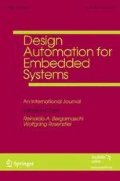Abstract
VLSI circuits are perceived to dissipate extra power during testing when compared with that of the normal function. Drastic heat may reduce circuit consistency, shoot up package cost, and even cause permanent damage to the circuit under test. Thus minimization of test power has gained increased significance. This paper explores the avenues in power minimization during test application in CMOS VLSI circuits since power consumption during testing is high when compared to normal operation. Design of low transition Test Pattern Generators is one usual method adopted to reduce power consumption. In the Proposed Modified Low Transition Linear Feedback Shift Register, power dissipation during testing is reduced by minimizing the switching activity between successive test vectors by comparing the two consecutive test vectors and inserting random bit such that total number of transitions is reduced without affecting the randomness. Significant advantage of this method is reduced power consumption with reduced complexity when compared to other existing methods. Considering experimental results there is a significant reduction in power consumption up to 36.2% for ISCAS’85 combinational bench mark circuits and up to 10% for ISCAS’89 Benchmark sequential circuit with marginal increase in area overhead.









Similar content being viewed by others
References
Chakravarty S, Dabholkar V (1994) Two techniques for minimizing power dissipation in scan circuits during test application. In: Proceedings of Asian test symposium. pp 324–329
Girard P (1999) Low energy BIST design: impact of the LFSR TPG parameters on the weighted switching activity. In: Proceedings in the IEEE international symposium on circuits and systems ISCAS 99, May 30-June 2. pp 56–58
Rosinger P, Al-Hashimi BM, Nicolici N (2004) Scan architecture with mutually exclusive scan segment activation for shift and capture-power reduction. IEEE Trans Comput Aided Des Integr Circ Syst 23(7):1142–1153
Lai N, Wang S (2002) A reseeding technique for LFSR-based BIST applications. In: Proceedings of the 11th Asian test symposium, November 2002. pp 200–205
Tehranipoor M, Nourani M, Ahmed N (2005) Low transition LFSR for BIST-based applications. In: Proceedings of the 14th Asian Test Symposium (ATS’05), pp. 138–143
Wang S, Gupta SK (2006) LT-RTPG: a new test-per-scan BIST TPG for low switching activity. IEEE Trans Comput Aided Des Integr Circ Syst 25(8):1565–1574
Chen X, Hsiao MS (2007) An overlapping scan architecture for reducing both test time and test power by pipelining fault detection. IEEE Trans VLSI Syst 15(4):404–412
Wang S (2007) A BIST TPG for low power dissipation and high fault coverage. IEEE Trans VLSI Syst 15(7):777–789
Nourani M, Tehranipoor M, Ahmed N (2008) Low transition test pattern generation for BIST based applications. IEEE Trans Comput 57(3):303–315
Yang MH, Kim Y, Chun S, Kang S (2008) An effective power reduction methodology for deterministic BIST using auxiliary LFSR. J Electron Test 24(6):591–595
Abu-Issa AS, Quigley SF (2009) Bit swapping LFSR and scan chain ordering : a novel technique for peak and average power reduction in scan based BIST. IEEE Trans Comput Aided Des Integr Circ Syst 28(5):755–759
Zhou B, Xiao LI, Ye YZ, Wu XC (2011) Optimization of test power and data volume in BIST scheme based on scan slice overlapping. J Electron Test 27(1):43–56
Strauch T (2012) Single cycle access structure for logic test. IEEE Trans VLSI Syst 20(5):878–891
Liang F, Zhang L, Zhang G, Gao K, Liang B (2013) Test patterns of multiple SIC vectors: theory and applications in BIST schemes. IEEE Trans VLSI Syst 21(4):614–623
Lien WC, Lee KJ, Hsieh TU, Ang WL (2013) An efficient on chip test generation scheme based on programmable and multiple twisted ring counter. IEEE Trans Comput Aided Des Integr Circ Syst 32(8):1254–1264
Tseng W, Lee LJ (2007) Reduction of power dissipation during scan testing by test vector ordering. In: Proceedings of the international workshop on microprocessor test and verification, December 2007. pp 15–21
Maiti TK, Chattopadhyay S (2008) Don’t care filling for power minimization in VLSI circuit testing. In: IEEE international symposium on circuits and systems, May 2008. pp 2637–2640
Wu Q, Qiu Q, Pedram M (2001) Estimation of peak power dissipation in VLSI circuits using the limiting distributions of extreme order statistics. IEEE Trans Comput Aided Des Integr Circ Syst 20(8):942–956
Lai NC, Wang SJ, Fu YH (2006) Low power BIST with a smoother and scan chain reorder under optimal cluster size. IEEE Trans Comput Aided Des Integr Circ Syst 25(11):2586–2594
Ding CS, Hsieh CT, Wu Q, Pedram M (1997) Stratified random sampling for power estimation. In: Proceedings of the 1996 IEEE/ACM international conference on Computer-aided design. IEEE Computer Society, pp. 576–582
Krishna KM, Sailaja M (2014) Low power memory built in self test address generator using clock controlled linear feedback shift registers. J Electron Test 30(1):77–85
Arvaniti E, Tsiatouhas Y (2014) Low-power scan testing: a scan chain partitioning and scan hold based technique. J Electron Test 30(3):329–341
Hollmann HENK (1990) Design of test sequences for VLSI self-testing using LFSR. IEEE trans inf theory 36(2):386–392
Author information
Authors and Affiliations
Corresponding author
Rights and permissions
About this article
Cite this article
Vellingiri, G., Jayabalan, R. An improved low transition test pattern generator for low power applications. Des Autom Embed Syst 21, 247–263 (2017). https://doi.org/10.1007/s10617-017-9188-6
Received:
Accepted:
Published:
Issue Date:
DOI: https://doi.org/10.1007/s10617-017-9188-6




